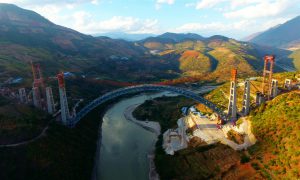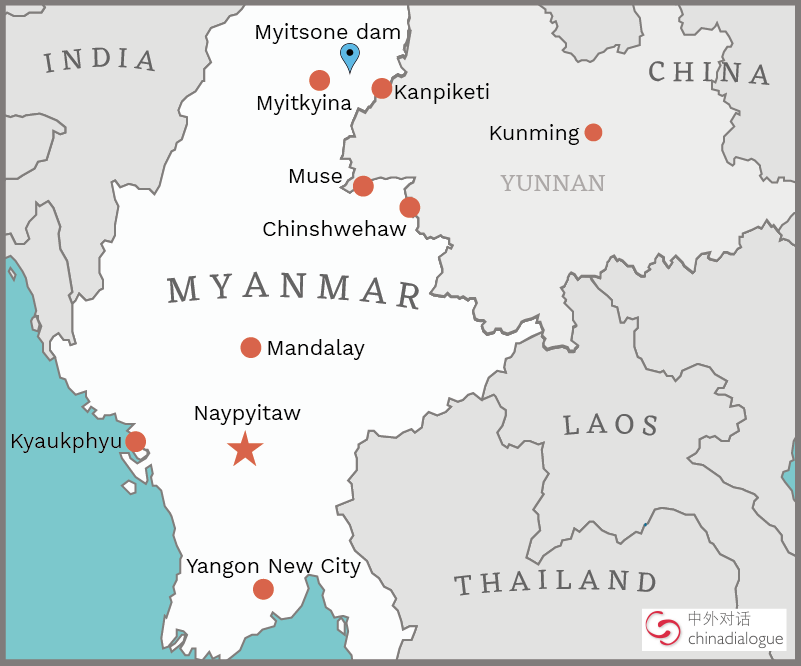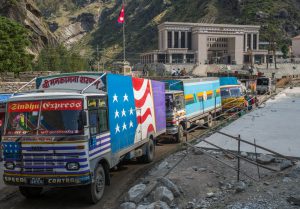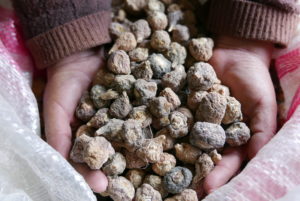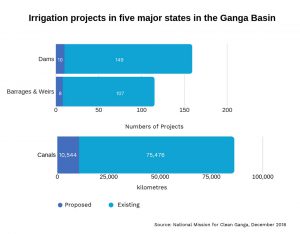A year ago, Myanmar and China signed an agreement to establish the China-Myanmar Economic Corridor (CMEC), as part of China’s Belt and Road global infrastructure initiative. Today, that corridor is mired in conflict between the Myanmar military and ethnic armed groups.
Stretching 1,700km, the CMEC’s network of new railways, trade zones and other major infrastructure projects is meant to mesh the comparatively impoverished economy of Myanmar with its wealthier neighbour’s landlocked southern province of Yunnan. However, ongoing armed conflict and lingering resentment against Chinese investments mean the future of the CMEC is uncertain.
Since its transition to semi-civilian rule in 2011, Myanmar has proven to be more cautious with Chinese investments than other developing countries. In August 2018, Myanmar officials negotiated an 80% cost reduction to the proposed Kyaukphyu deep-sea port, trimming the project from over US$7 billion to US$1.3 billion, Reuters reported. The Myanmar side, led by deputy finance minister Set Aung, baulked at the risk of an excessive debt burden.
This mindset has extended to new CMEC deals, where Myanmar officials have successfully set out conditions for major Chinese investments, insisting on the right to open tenders and the ability to seek international financing. So far, out of 38 projects proposed by China for the CMEC, Myanmar’s government has approved nine.
If China wants the CMEC to succeed, its companies need to regain the public’s trust in Myanmar and show that “win-win” scenarios are not mere words, particularly in the country’s sensitive border regions. Development benefits need to be distributed equitably across the population, rather than concentrated in the hands of Myanmar’s military strongmen and economic elite. Otherwise conflict will continue to plague China’s plans abroad.
Flagship projects
One of the most prominent CMEC projects in the pipeline is the Muse to Mandalay railway, estimated to cost US$9 billion. The project involves the construction of 431km of new track that will link up with Yunnan’s high-speed Dali to Ruili line. A feasibility study completed by China Railway Eryuan Engineering has been submitted to the Myanmar government, but environmental and social impact assessments remain incomplete. A second phase may extend westwards to Kyaukphyu’s new port and special economic zone, and south towards Yangon. There, China Communications Construction Co. is set to develop over 1,500km2 of land for the New Yangon City project. The first stage envisages transforming over 8,000 hectares of flood-prone farmland into an urban industrial zone.
If built, these massive infrastructure projects are poised to radically transform Myanmar. The expansion of highways and railroads across the country will accelerate the flow of trade, labour and capital, tying Myanmar’s future ever closer to China’s. Yet the underlying questions remain: what kind of future is envisioned for the country, and who gets to decide that vision?
Though the Myanmar government’s negotiating stance and conditions focus on financial and fiscal sustainability, many of the glaring issues with Chinese investments in Myanmar concern the socio-economic and environmental impacts of large-scale development projects on already marginalised groups. China’s state-owned enterprises (SOEs) have already encountered strong resistance to their resource extraction and energy infrastructure projects.
The most infamous Chinese investment project in Myanmar is the Myitsone dam, a 6,000-megawatt hydropower project that would have displaced over 10,000 villagers in Kachin state. The mega-dam was suspended unilaterally in 2011 by Myanmar’s then-president, Thein Sein, and attempts to revive the Myitsone dam as part of the CMEC were met with nationwide protests and rallies in early 2019.
Protests have also arisen along the 770km pipelines that carry oil and gas from Kyaukphyu in conflict-ridden Rakhine state to Kunming, the capital of Yunnan. Communities along the route are demanding fair compensation from the Chinese SOEs for the negative impact on their livelihoods due to loss of land.
In light of these grievances, Chinese SOEs are trying to demonstrate the tangible benefits of Myanmar’s participation in the BRI. In the years since the twin pipelines’ construction, the Southeast Asia Gas Pipeline Co. (majority-owned by China National Petroleum Corp.) has donated US$25 million for the construction of schools, clinics and water supply systems for rural communities along the pipeline route.
At the Second Belt and Road Forum in Beijing in April, China agreed to provide a one billion yuan (US$144 million) grant to the Myanmar government for improving livelihoods, conducting feasibility studies for major projects, and delivering humanitarian assistance for the tens of thousands of people in northern Myanmar internally displaced by civil war.
But aid grants and corporate social responsibility will not dislodge the roots of unrest in Myanmar, which are intertwined with the Myanmar military’s long-running wars in ethnic minority states.
Infrastructure development during wartime
In order to promote socio-economic and environmental sustainability in Myanmar’s border regions, China’s new development plans need to take into account the political legacies of decades of civil war. The planned infrastructure projects pass through highly volatile areas where armed groups continue to fight over territory with each other as well as with the Myanmar military.
In mid-August, the Northern Alliance – a coalition of ethnic armed groups seeking autonomy – launched attacks that shut down the government-controlled Muse and Chinshwehaw trade routes with China. Millions of dollars’ worth of cargo was stranded on both sides of the border. In response, China convened peace talks between the Myanmar military and the Northern Alliance, but negotiations have yet to bear lasting results.
China has been actively engaged in Myanmar’s peace process for years, but any political solution rests heavily on the economics of natural resource extraction in Myanmar. Decades of ethnic struggle over territory and sovereignty have created a patchwork of fiefdoms controlled by armed groups, where some remain in active conflict with the military. Others have signed ceasefires in exchange for business concessions.
A long history of engagement between Chinese financing and ethnic armed groups on the border has fuelled the unregulated extraction of natural resources – in logging, mining and plantations. Many of these armed groups fund themselves through economic relations with their Chinese networks in Yunnan. Up until recently, such relations were handled by Yunnan provincial authorities that benefited economically from loosely regulated trade.
The CMEC projects are partnerships between the Myanmar government and Chinese SOEs, while natural resource extraction has been carried out by the ethnic armed groups and private Chinese investors. Pushing an infrastructure development agenda through such a complex political landscape risks making existing inequalities and tensions more complicated.
Plantation problems in Kachin state
Together, the intertwined issues of ongoing war in border regions and land seizures for development projects in Myanmar present complex challenges for Chinese decisionmakers working with the Myanmar government. The massive volume of investment capital from China also heightens the risks of environmental degradation. Without more stringent regulations, the CMEC’s planned road and rail upgrades threaten both rural livelihoods and biodiverse ecosystems.
Myanmar’s rapid deforestation rate is a result of increased traffic through previously remote regions, such as the highlands of Kachin state, now made accessible by all-weather roads. Many of them have been built by Chinese logging companies to transport illegally felled timber to Yunnan.
Deforestation is also driven by the conversion of forests into plantations for agricultural commodities like bananas and rubber, backed by private Chinese investment. According to civil society and government reports, Chinese-run banana plantations in Kachin state have increased dramatically, from 2,500 hectares in 2007 to over 40,500 hectares in 2018. The vast majority of the plantations are located in Waingmaw township, adjacent to the border with China.
These rapidly expanding plantations grow tissue culture bananas, and the clonal genetic material and monoculture production require constant applications of chemical fertilisers and pesticides. These chemicals have poisoned local communities’ water supplies and aquatic ecosystems.
As tissue culture banana cultivation depletes the soil’s fertility, agri-business owners constantly need to acquire more land for production. Some Chinese-backed plantations are now found on land used by Kachin farmers until they were displaced by fighting between the Kachin Independence Army and Myanmar’s military.
Other plantations in Kachin state are in the border area controlled by the National Democratic Army-Kachin (NDA-K), an armed group that has converted into a Border Guard Force under Myanmar military command. As private investors from Yunnan make inroads into an unregulated agricultural sector, the military-backed authority of the NDA-K facilitates corporate impunity. The frontier towns of Pang Wa and Kanpiketi, under NDA-K authority, are set to be transformed by one of the CMEC’s cross-border trade zones.
Environmentally disruptive banana plantations are just one manifestation of a political and economic system in northern Myanmar that privileges power and profit over people. In this context, the Kachin state government and a Yunnan company are jointly developing the Myitkyina Economic Development Zone, which is envisioned as a hub of industrial agriculture production and processing.
CMEC planners and corporations must consider the ripple effects of the new projects on both society and the environment. What kind of development model will the new trade and energy infrastructure bring? How will those changes affect the political landscape of Myanmar’s civil war and peace process? Will China’s economic influence strengthen environmental degradation and violent conflict along the border, or generate tangible improvements in the lives of Myanmar’s diverse peoples?
If the CMEC is to avoid exacerbating existing problems, China’s national and provincial planners need a better understanding of how flows of capital from China to Myanmar facilitate the territorial control of armed strongmen – both in the Myanmar military and non-state armed groups — who are driving the political chaos and instability of the border regions today.
A green BRI will need more than economic investment alone. Given the de facto absence of functioning regulation or any guarantees for local communities’ livelihoods in northern Myanmar, Chinese investment capital thus far has facilitated the degradation of the border region’s ecologically and culturally diverse landscapes. A broader and more inclusive coalition of stakeholders, particularly grassroots civil society groups that are most attuned to the needs of local communities, must be involved in development planning and decision-making processes for Myanmar’s border regions.
